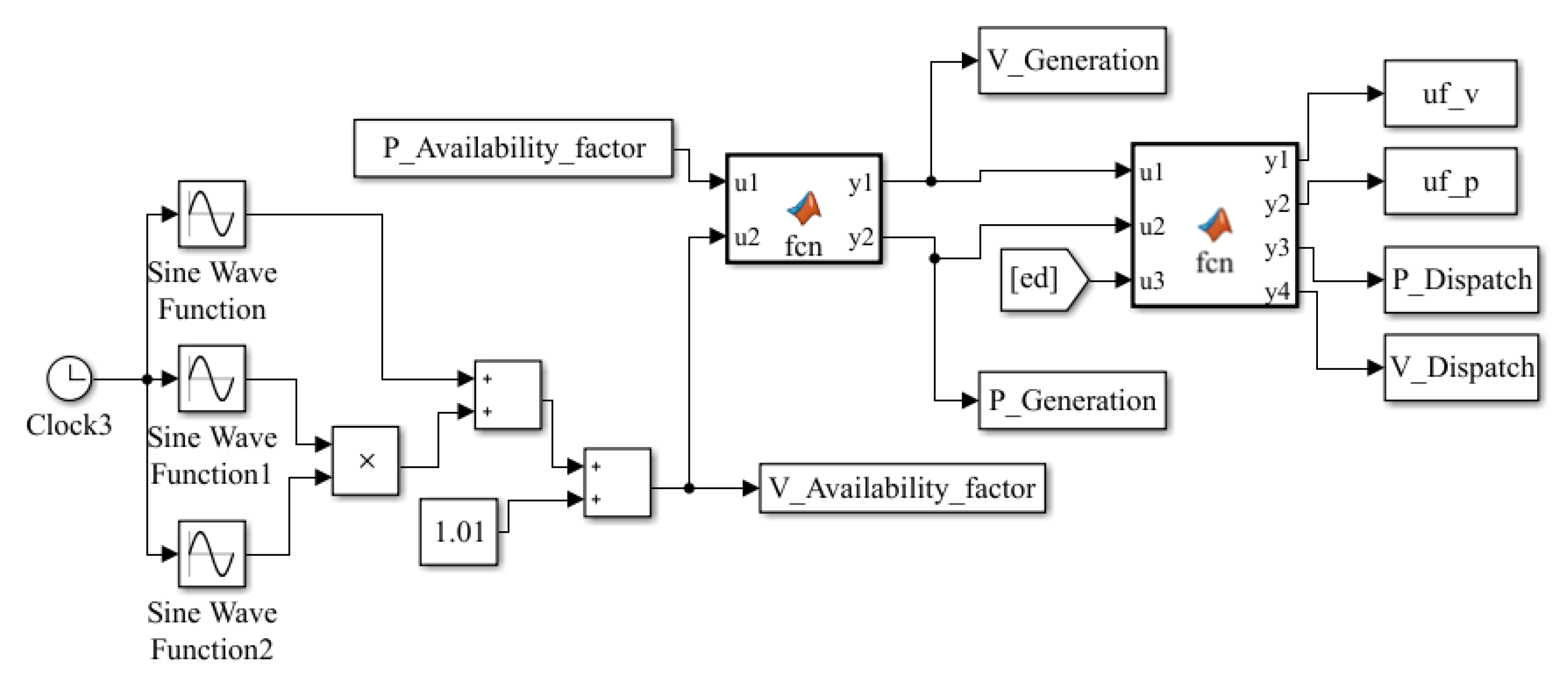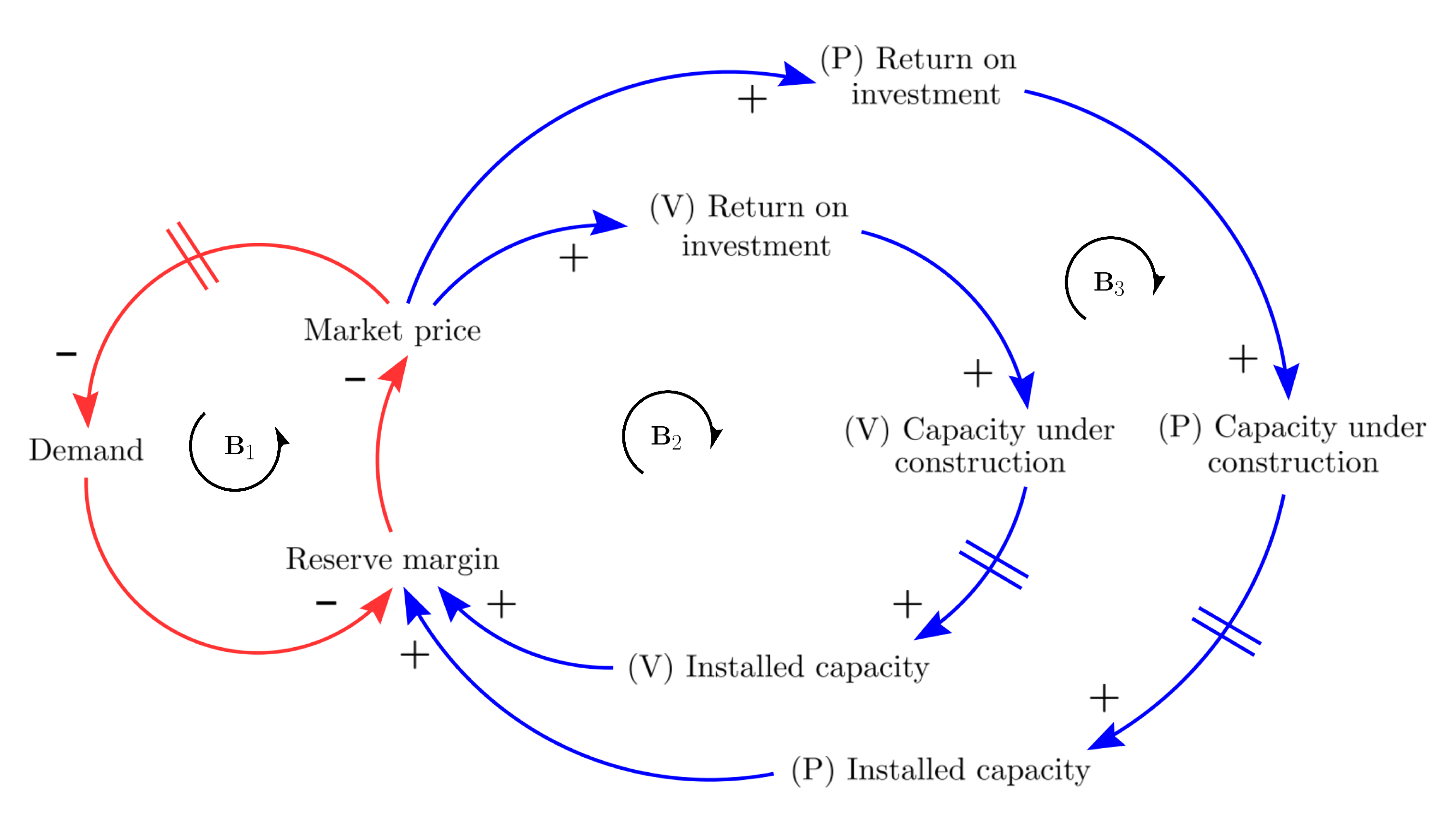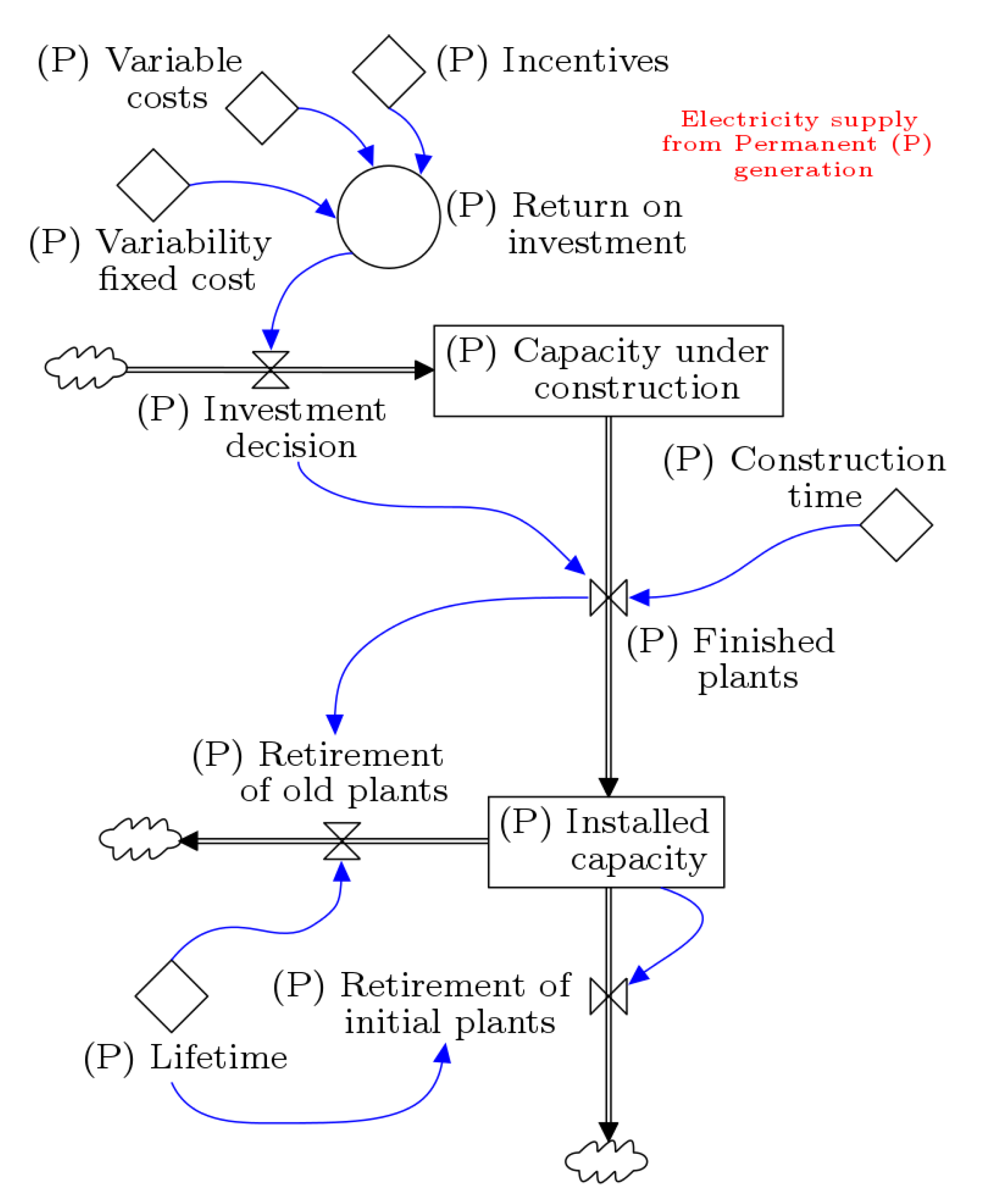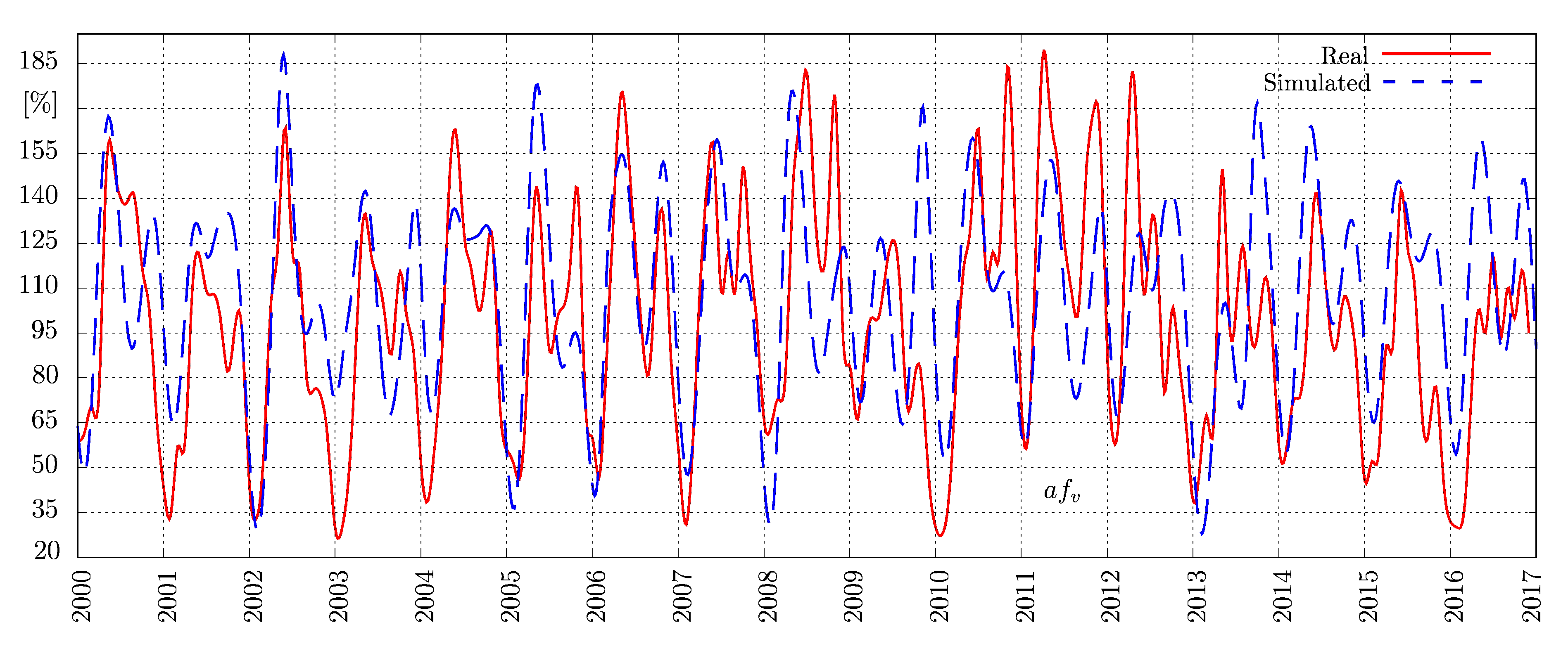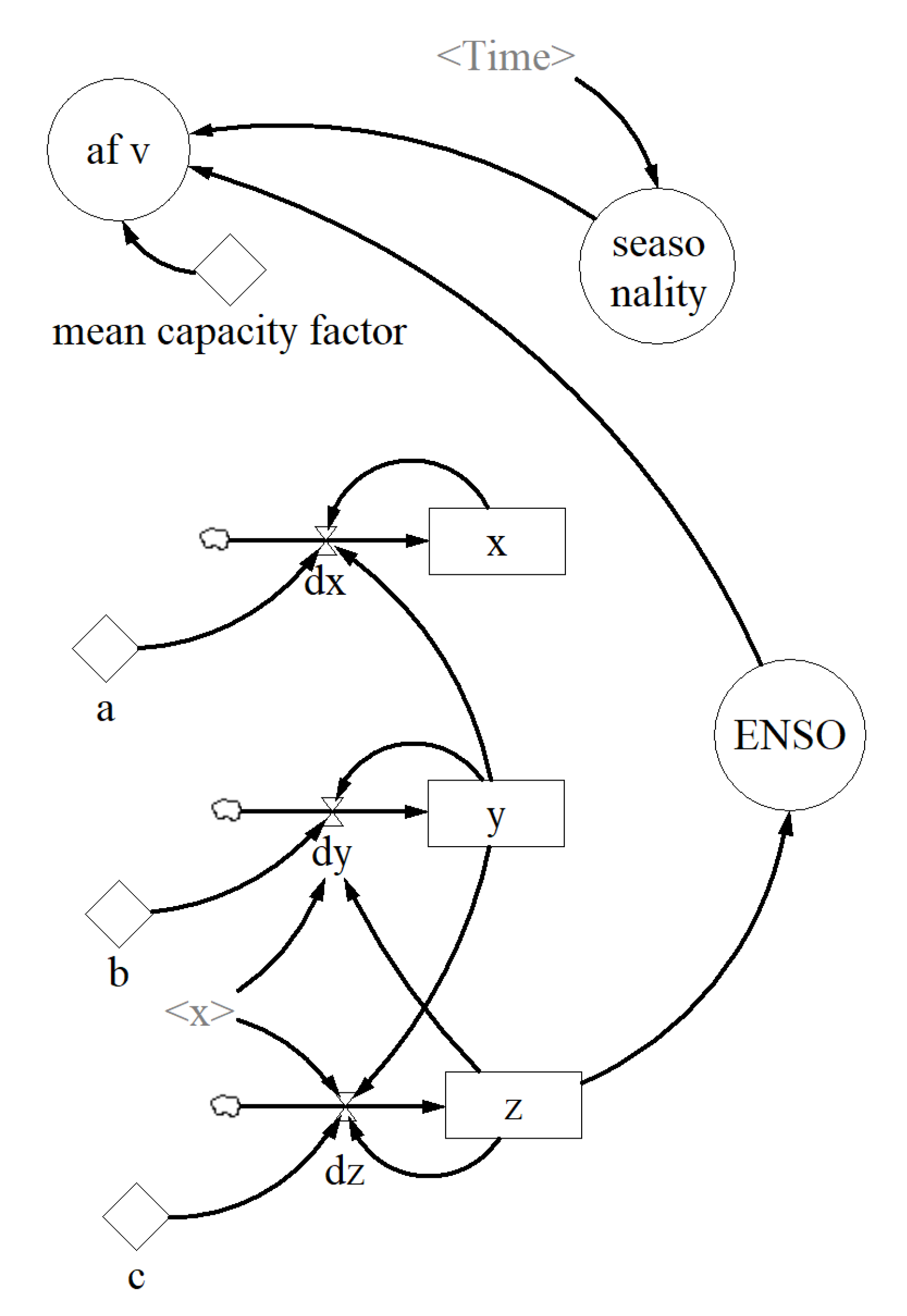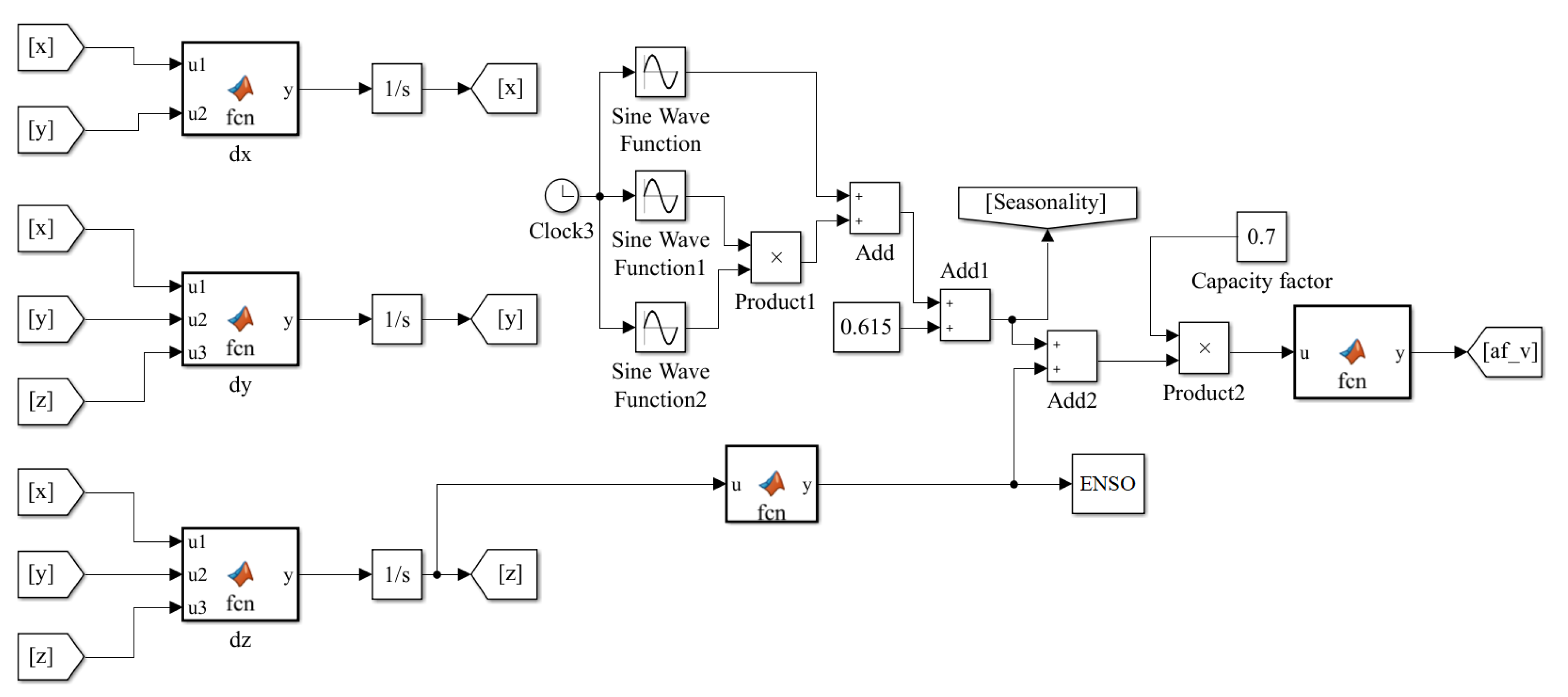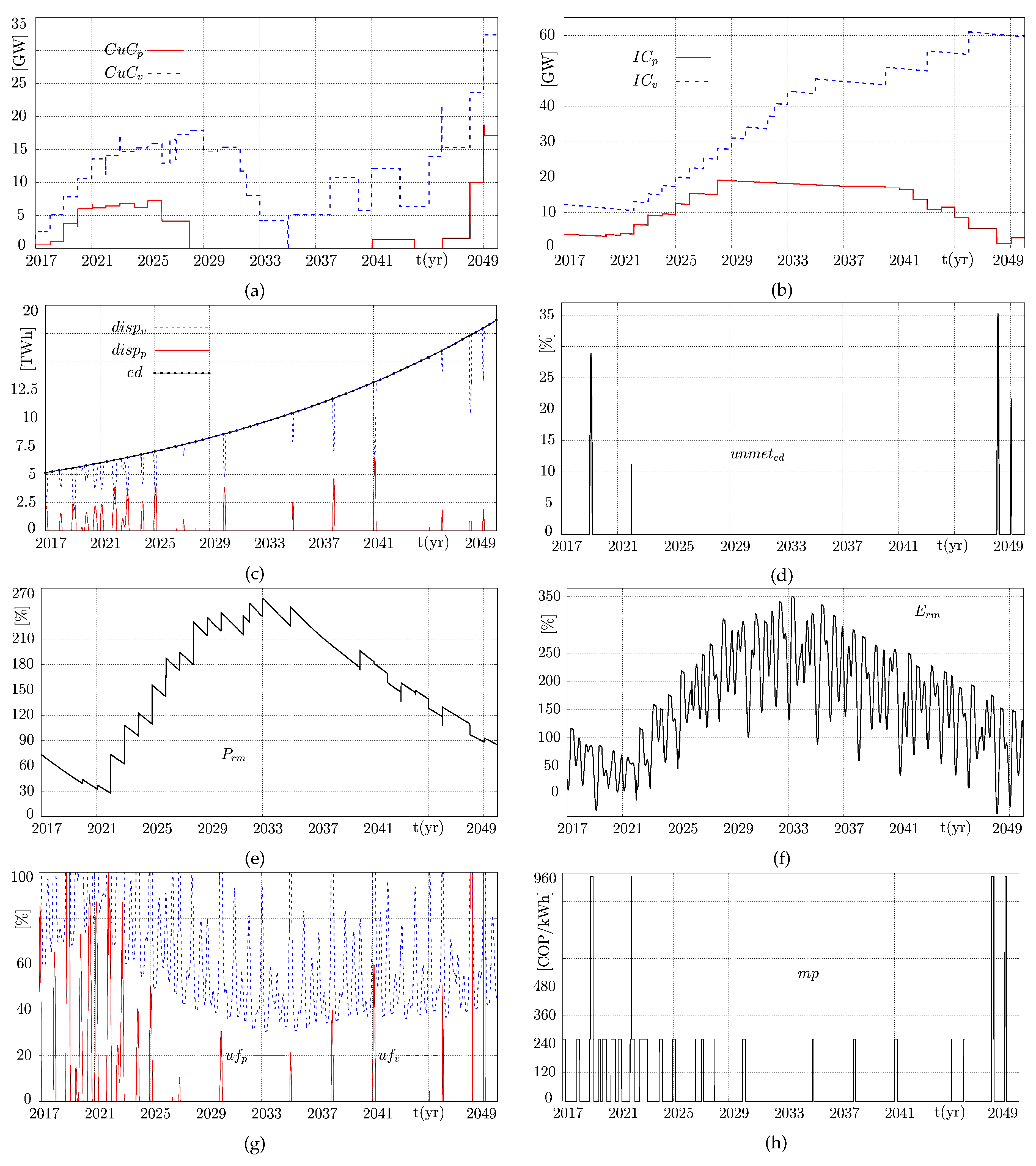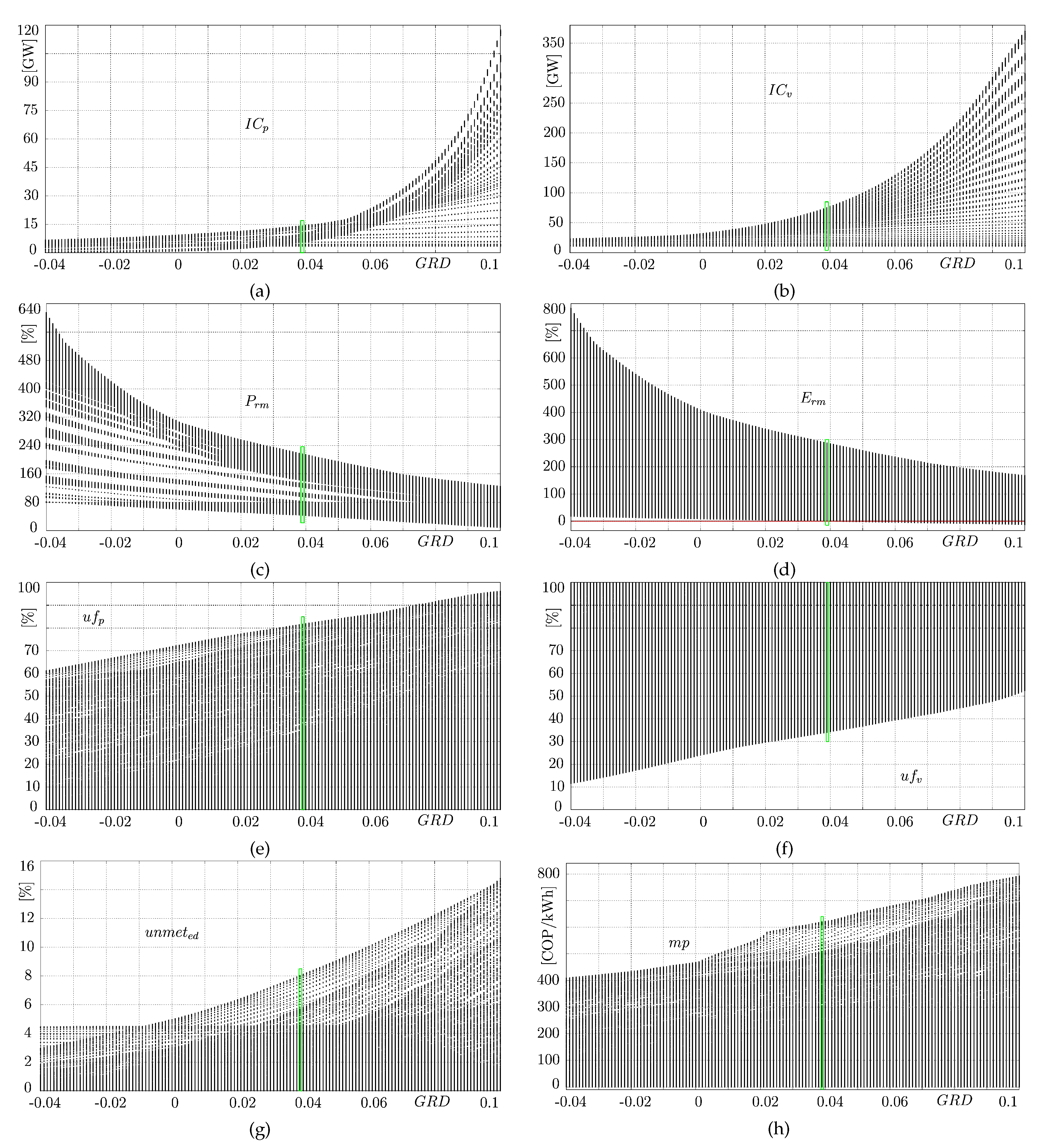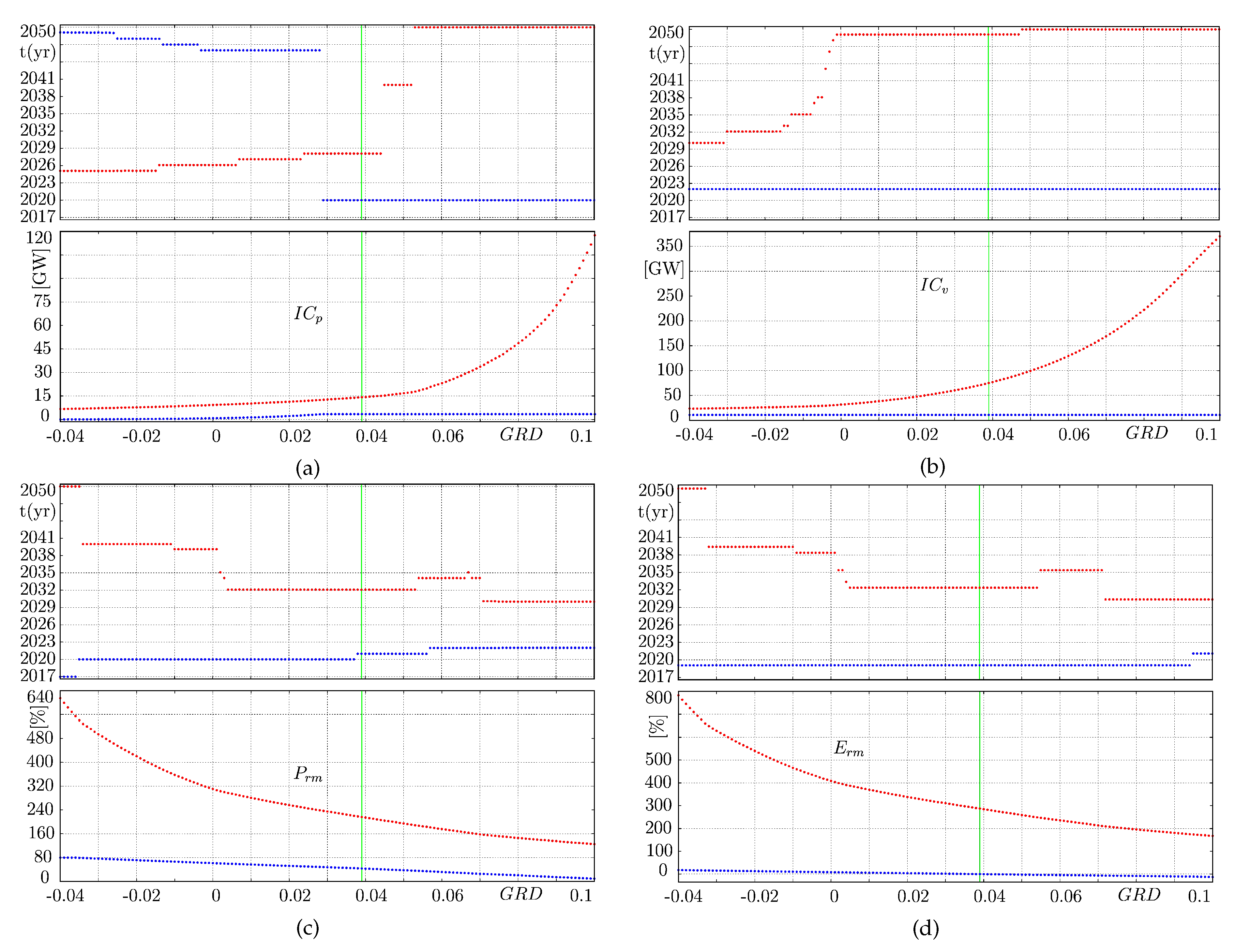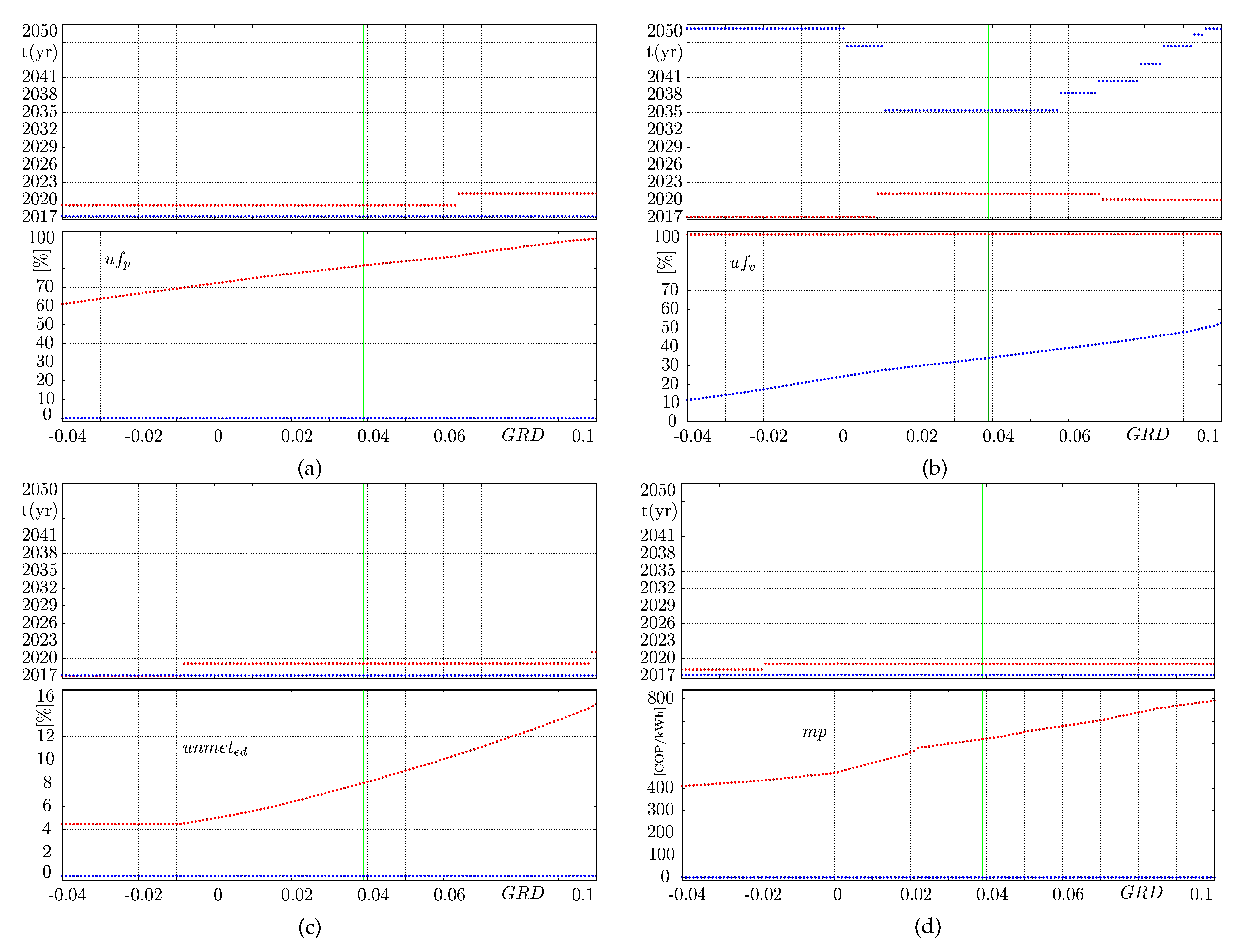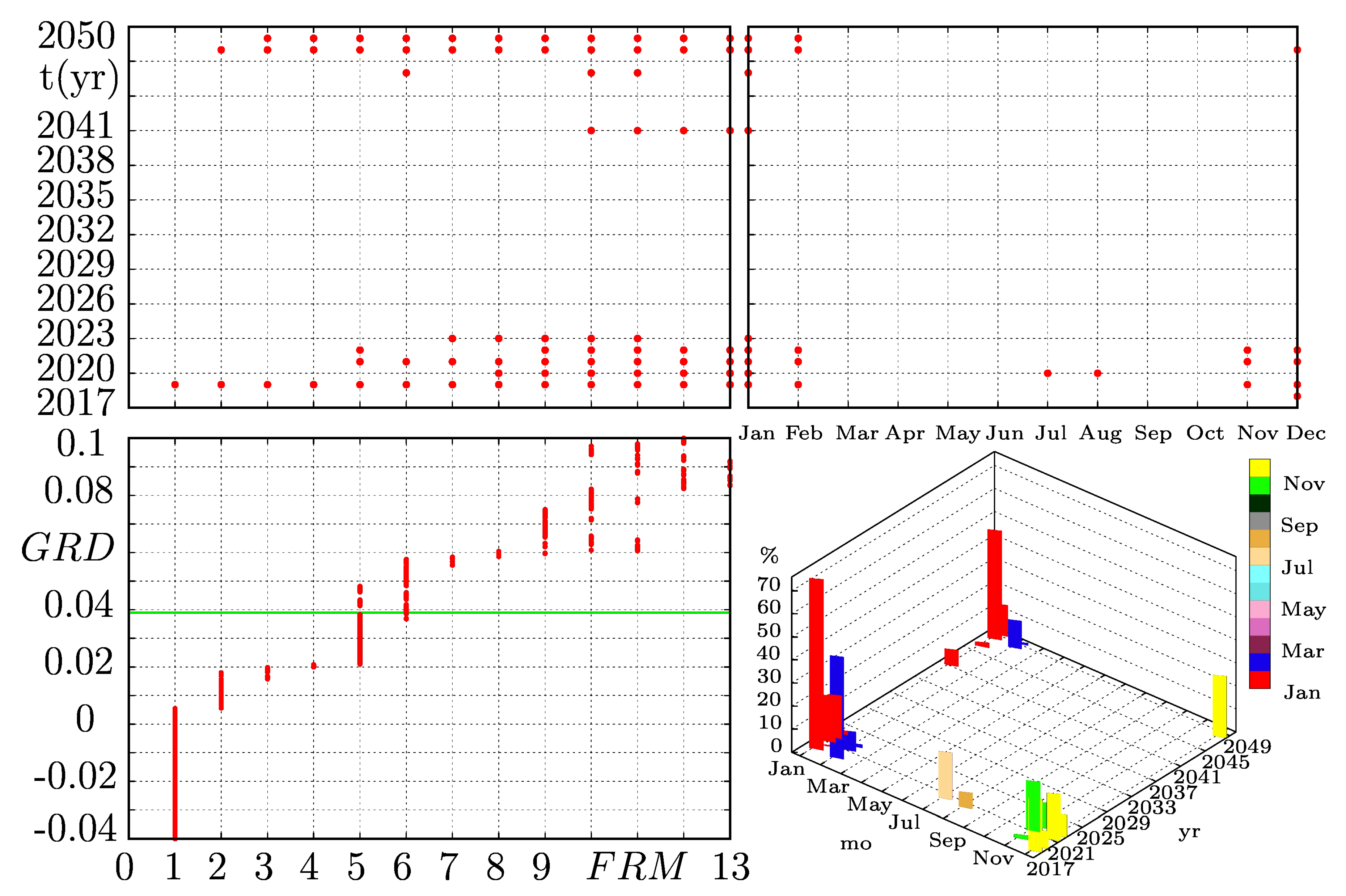5.2. Simulation of the Colombian Electricity Market
In this section, both the seasonality and ENSO phenomenon are considered for modeling the variability of hydropower plants as explained before. The stock-flow structure is shown in
Figure 2,
Figure 3,
Figure 4 and
Figure 5. The Colombian parameter values used in this section are shown in
Table 2.
Now let us show how the seasonality and the ENSO phenomenon affect the main characteristics of the simplified Colombian electricity market in
Figure 9. These simulations were obtained by considering the BaU scenario, i.e., with the current policies and average population growth. As can be seen, the chaotic component of the ENSO phenomenon has been introduced to the overall market dynamics. Here, the ENSO phenomenon gives rise to several unexpected situations. Generally, the variability of the hydropower generation produced by seasonality and ENSO phenomenon forces the system to use more thermal generation not only in the short and long run but also over the middle term. Clearly, the El Niño phenomenon makes the electricity supply dependent on more permanent generation along the 33-years of simulation. The short and long runs are also the two most critical situations.
Figure 9d shows that unmet
events are expected in 2022, 2048, and 2049, whereas the security of supply is maintained in the middle run.
In
Figure 9a,b, the dynamics of the capacity under construction of the permanent (
) and variable (
) generation and the installed capacity of the permanent (
) and variable generation (
) are shown, respectively. Similarly,
Figure 9c shows the interaction of the electricity dispatch of the permanent (
) and variable (
) generation for meeting the
. As a result of this process, it is measured the unmet
(
), as shown in
Figure 9d. In this sense, the reserve margin can also be observed in
Figure 9e,f since it can be measured in terms of its power (
) and energy (
). Additionally, the dynamics of the utilization factor of the permanent (
) and variable (
) generation can also be observed in
Figure 9g. Finally, the market price behavior of the system is observed in
Figure 9h.
Nevertheless, the previous simulations were obtained for only one initial condition of the Lorenz attractor, that is, only one possible reality. As we discussed above, chaotic attractors are very sensitive to changes in their initial conditions. Therefore, every change in the initial condition of the Lorenz attractor can be a different possible reality and therefore in . Thus, we can change the initial condition of z and generate very different synthetic series. However, the question arises as to how many synthetic series should be computed.
To address this question, we computed the variance of one of the market variables under many different initial conditions (synthetic series). Then, we determined the number of synthetic series that should be computed to always guarantee the generation of different synthetic series or realities of .
In this context, let us show
Figure 10, which shows the variance of the
. Note that by setting different initial conditions to the Lorenz attractor, different scenarios or the behaviors of the
were obtained, especially in the first 2000 simulations. After 4000 simulations, although the initial condition was still being changed, the variance reached an equilibrium point. Thus, irrespective of the continued variation in the initial condition of
z, the resulting synthetic series do not change significantly. Consequently, by simulating the electricity market model up to 4000 times, we guarantee 4000 different synthetic series. In fact, we can consider such 4000 possible realities for studying different
scenarios.
5.3. Demand Growth Scenarios: A Bifurcation Perspective
So far, the BaU scenario under seasonality and ENSO phenomenon is explained with only one possible reality out of 4000. However, population, economic growth, energy efficiency improvements, and diffusion of self-generation with solar panels, are all key influences in energy demand. Therefore, in this section, we provide low and high demand growth scenarios, as well as a broad spectrum of scenarios by simulating 4000 possible realities of the Colombian power market.
To perform this study, we used the parameter
shown in
Figure 4. This parameter represents the population and economic growth, which directly influences the
dynamics. Accordingly, the
was varied from −0.04 to 0.1. For each
value, our model was simulated 4000 times. However, for representation purposes only, the average dynamics of all 4000 synthetic series are illustrated, which enables us to observe a smoother behaviour of the system variables. Considering that the simulation of such a huge number of synthetic series is limited by computational power, we only computed 200
scenarios. This means that we computed a total of 800,000 synthetic series.
A more advanced sensitivity analysis diagrams are shown in
Figure 11 based on the concept of bifurcation diagrams. Notably, our model is characterized for exhibiting an infinite transient behavior (stable solutions are not achievable) due to the strong dependence on continuously growing investment decisions and demand. Nevertheless, the concept of bifurcation diagrams is used for not only the last values of the synthetic series (as commonly done for physical systems), but also the short, middle, and long run values of the simulations, as stated in [
19,
39], as a map of all possible scenarios.
As shown in
Figure 11a,b, the seasonality and ENSO phenomenon do not significantly influence the dynamics of
and
; chaotic or variability components are not displayed in both diagrams. Only a continuously growing pattern can be observed as
increased. Since all synthetic series were averaged, the sensitivity diagrams show a smoother behavior pattern. In fact, as we explained before, because of the merit order effect, the
is always above the
. This suggests that, regardless of the variability of hydropower generation and the
scenario, renewable and fossil fuel capacities tend to increase in the short term and in the long term. Nevertheless, the hydropower capacity always grows faster than the thermal capacity for well-known environmental reasons.
Note that for the Colombian case (green rectangle),
and
reach maximum values of 14 and 72 GW, respectively, close to the possible reality shown in
Figure 9b.
reaches this value almost at the end of the simulation (2046), whereas
, near 2028. Thus, the variability imposed by the ENSO episodes is very strong and thus forces the thermal capacity to grow and the hydropower capacity to decrease correspondingly. The electricity market tries to mitigate such strong variability by using more permanent or thermal generation. Accordingly, we can expect to have the same conclusion for all
scenarios.
Conversely, note that negative values of the
do not incentivize the expansion of both
and
, which is explained by the continuous drop in consumption due to decreasing
. Moreover, by increasing the value of the
, one can see a clear growth in both installed capacities. Particularly, the
exhibits exponential growth. The
, conversely, presents a slower exponential growth more concentrated for large values of
, and no intermittent complex dynamics are observed because the permanent capacity is larger and thus less critical values of
are exhibited or, at least,
does not abruptly change (see
Figure 11d). Both the nearly smooth growth of
and
and the larger share of permanent generation give rise to a less variable
.
Figure 11c shows that
shows positive margins for all
values. However, although more permanent capacity is installed when the ENSO is part of the model, its stronger variability leads
to more critical instances as
increases; consequently, negative
values are more likely to occur for larger
scenarios, as shown in
Figure 11d. Almost all positive
scenarios lead to a similar negative
value, which is more pronounced around
= 0.09. The question arises whether it occurs in the short or long run, which we discuss in the following section.
Furthermore, when the
is decreasing (
< 0), both
and
grow higher than other
scenarios, but critical values are reached as well at some time in the simulation. In fact, when we further increase the
,
and
smoothly decrease and become more critical. For the Colombian case, particularly,
might cross the red line in 2021–2022, 2048, and 2049, as shown in
Figure 9d. The Colombian case is part of the most dangerous
scenarios seen in this figure (for
= 0.02 onward).
Our electricity market model, which now incorporates the ENSO phenomenon, exhibits
events for all
scenarios, as illustrated in
Figure 11g. Note that for some parameter values
could be very high, whereas others could be low. In Colombia, the
is close to 0.039, and as shown in
Figure 9d, it might be possible to have
≈ 12%, 35%, and 22% in 2022, 2048, and 2049, respectively. However, these values correspond to only one of the 4000 possible realities computed; therefore, after averaging all the 4000 synthetic series of
, a maximum value of 8% is obtained for the Colombian case, as illustrated in
Figure 11g, which we further investigated in this work. In fact, the risk to have
events is imminent. Indeed, it might be the worst if the
increases. It appears that the only way to avoid such critical situations is by installing new permanent or variable capacity before 2021, only by doing so, Colombia might change its energy future landscape. Colombia urgently needs a new capacity to change its overall energy future prospective. Considering that it is expected to have a larger
over time, Colombia could be subjected to an increasing risk of undergoing significant
episodes.
From
Figure 11h, one can see that
events can also be detected from the
. Recall that when
becomes zero or negative, the system sends a signal of setting a
in the
; therefore, one can see in the
that the signal of
is set in all
scenarios since the maximum price reached by the system is above
. In other words, the
takes values between
and
, and at some time, it also takes a
. For this reason, the sensitivity diagram captures values ranging from 0 to 800 COP/kWh. The smaller the value of the
scenario, the cheaper the
will be for consumers. Obviously, a small
value leads to fewer rationing episodes over time, which in turn, guarantees cheaper prices for consumers. The question arises whether the
is set in the short or long term, which shall be further investigated, but it can be partly inferred from the
dynamics explained above.
Additionally,
Figure 11e,f illustrate the participation of each technology of generation in the dispatch merit order. As shown, hydroelectricity power plants (
) are used in all
scenarios ranging from no less than 12% and up to 100%. However, this interval of participation shrinks as the
further increases, basically because it is necessary to mitigate the ENSO variability by installing more permanent capacity and reducing the variable one. For instance, in the Colombian case
ranges from 35% to 100% depending on different conditions, whereas for
= 0.1, one would expect
ranging from 53% to 100%, 18% less participation than the Colombian scenario. The thermal plants are not used at their full potential (
= 100%) because more thermal and less variable capacities are installed so that less participation from permanent generation is needed to meet the
. However, for negative values of
, the participation of renewable power plants can be larger since the appearance of rationing events is less unlikely.
Evidently, the larger the values of
, the more electricity is needed to be able to meet the increased
; therefore, the participation of thermal power plants is larger for those
scenarios. The thermal power plants are less used for all
scenarios (a large permanent capacity together with a significant variable one can meet the required
sufficiently), for
between 0% and 95%. Under the current market structure, the full potential of thermal plants is not necessary for supporting the hydropower generation, meeting the
, and avoiding the rationing events; however, it can be unavoidable because of the complex dynamics of the hydropower variability, as shown in
Figure 11d,g.
5.4. Confidence Limits and Their Occurrence
Advanced sensitivity diagrams based on bifurcation theory were obtained above to provide a deeper insight into the Colombian electricity market against variations and under variability imposed by seasonality and ENSO phenomenon. However, it is essential to investigate the confidence limits together with their time of occurrence. We applied DS tools to reach our goal and incentive this novel form of analysis for SD models that can extract more and complete information of possible scenarios.
As shown in
Figure 12 and
Figure 13, under the DS perspective, more information can be extracted from our SD model based on the bifurcation theory by illustrating the confidence limits together with their corresponding year of occurrence. In other words, the maximum and minimum values reached by the key market variables were plotted for each
scenario.
As a first step, let us consider
Figure 12a, which illustrates the confidence limits of
under different
scenarios. Note that 50% of the
scenarios (i.e., for negative
values and some positive ones, up to 0.028) indicate that the permanent capacity tends to increase and gets a maximum value in the short or middle run, after which it starts to drop until it reaches a minimum value (close to 0 MW) in the long run, near 2045. Under negative and small positive values of
, the power market might expect to have a significant permanent capacity installed for 8–11 years. Then, after about 25 years, one can expect a considerable reduction in thermal capacity. However, if the
of Colombia is 0.029 ≤
≤ 0.044, Colombia might expect to have a significant reduction of its permanent share in the short run (2020) caused by its natural depreciation, but also a large increment of it in the middle term (2028) caused by the critical rationing events expected to occur in the short run, which then incentive the thermal capacity expansion. In fact, if the
of Colombia increases (
> 0.045), the permanent capacity decreases in the short run, in 2020, but it might be necessary to incentivize a large increment of this capacity in the long run, about 2048, for supporting the variable renewable generation of such time. The
scenarios together with the ENSO variability give us three possible energy prospects for thermal power generation. One of them (for
< 0.029) suggests that the permanent capacity would continue to grow for at least 8 years, but it could disappear in the long term. The other one (0.029 ≤
≤ 0.044) suggests that the permanent capacity tends to disappear in the short term, but it might become important in the middle term because of the new capacity investments conducted in previous years to overcome the critical situations encountered in the short run. In contrast, if the
exceeds 0.045, it is very likely that the permanent capacity drops a lot in the near future but increases significantly in the long term to support the increasing variable renewable capacity.
Conversely, the behavior patterns of
(see
Figure 12b) never drop significantly in the long run regardless of the
scenario; its minimum value is always expected to occur around 2022 for the same reason explained above. Additionally, note that for −0.04 ≤
≤−0.015, the maximum
is achieved close to 2030. Conversely, for −0.015 ≤
≤ 0.1, the maximum
is normally achieved at the end of the simulation since the
is large enough to provoke critical values of
in prior years, which immediately incentivizes the investments in new hydropower capacity; however, the resulting increase in
occurs 5-years later (≈2049) because of issues associated with construction delays.
Furthermore, as shown in
Figure 12c,d,
and
differ by a number of properties. In general terms, both
and
always exhibit their lowest values in the short run (around 2020) because of the natural depreciation of power plants, which is expected to significantly affect the margin level until the first new capacity is ready to operate. Additionally, our electricity market model is expected to attain the maximum
and
levels, principally, in the middle term and in the long term. It means that all power plants that are built to support the critical situations in the twenties give rise to a margin level overshoot a few years later. After that, both
and
start to drop again but do not reach a critical value in the long run.
Moreover,
Figure 13a,b illustrate the confidence limits of
and
, respectively.
shows that the highest participation of thermal plants is basically required in the short run for all
scenarios. Clearly, 2020–2021 can be cataloged as very critical years for the environment since almost the full potential of the fossil fuel power plants might be necessary to cover the total
regardless of the
scenario. The lowest participation of thermal plants (Consequently, less CO
emissions provided by fossil fuel generation) took place during 2019, once again regardless of the
scenario. Thus, the ENSO phenomenon makes thermal power crucial for all
scenarios to guarantee the security of supply, especially in the short run as the risks of blackouts persist.
Moreover, shows that hydroelectricity plants participated with their full power in 2018, 2020, and 2021, indicating that the short run might be a very critical time for the Colombian power market if new and significant capacity is not installed prior to 2021. The worst cases for hydropower generation appear to be for negative and few positive scenarios and in the very long run; as shown, its participation goes from 12% to 25%. However, for most of the positive scenarios, the lowest participation of hydroelectricity plants (ranging from 25% to 52%) starts in the middle run because and have a safe value during this time. Clearly, as increases, the lowest participation of hydroelectricity plants becomes higher as well.
Finally,
Figure 13c,d show
and
, respectively. The ENSO phenomenon causes
episodes to appear for all
values. For negative
, electricity rationing is much less than in other cases. Within the
range (−0.04, −0.008), the worst
events occur in the very short run, whereas for
(−0.007, 0.1), including the Colombian case, the worst
cases are expected to occur close to 2021. In fact, the exponential shape of
corresponds to rationing events taking place in a relatively further run (and no electricity rationing events appear in the long run), whereas the flat shape of
suggests rationing events appearing in the very short run but also fewer pronounced rationing events than the exponential one. Accordingly, it can be seen in
Figure 13d that the
is present in all
scenarios and that the maximum
is reached close to 2021 regardless of the
scenario, whereas the hydroelectricity price (
) is detected as the minimum price in the short run, once again regardless of the
scenario. Although some rationing events appear and both thermal and hydropower plants dispatch electricity to meet the total
, it is expected that
that consumers perceive are mostly set by thermal producers, as shown in
Figure 9h.
As can be seen from
Figure 12 and
Figure 13, the policymakers can determine, for each market variable, the extreme conditions and when they are going to take place; this has never been constructed using SD models and has recently been introduced in [
20].
5.5. Detailed Rationing Events: A Control Theory Pperspective
Now let us consider in more detail all the possible rationing events of the scenarios under the presence of the ENSO phenomenon in our model. As we discussed and showed above, all scenarios may exhibit or rationing events if the ENSO phenomenon is incorporated in the model; therefore, here, we estimate the number of months expected to be under electricity rationing, their specific year, and even the exact month.
By using the input-output relationship diagram widely used in control theory through describing functions [
40], we develop a graphical tool that can specifically determine how long rationing events are expected to undergo, their year and month of occurrence, and the probability of such episodes.
Figure 14 shows the input-output relationship diagram computed for every
scenario; the bottom left diagram shows the
(frequency of rationing months), the upper left and right diagrams illustrate their corresponding year and month of occurrence, and the bottom right diagram shows their corresponding probability of occurrence. In fact, our model undergoes different
for each
scenario; particularly, note that for
values above 0.02, five or more months of electricity rationing are expected to occur during 2020–2023 and 2041–2050. According to the upper right diagram, these months might be mainly January, February, November, and December. However, January is prone to be the driest month of the year; hence, we infer January would most likely be the worst-case scenario for most of the
values. Then, the 3-D diagram shows that January 2021 is one of the possible worst-case scenarios since it has a nearly 30% probability of occurrence. We conclude that if the
reaches positive values, it is very likely that the power market undergoes an electricity crisis mainly in January in the short run and in the long run. Since Colombia went through a serious electricity shortage in 2019 due to the Hidroituango delay, which is also shown using our simulation model, the government should pay attention to the coming years to avoid unmet
events.
In more detail,
Figure 14 shows that Colombia might undergo 5 months of electricity rationing. If we look at the mapped upper left diagram, it can be observed that these 5 months might take place in 2021, 2022, 2048, or 2049. However, it is possible to verify from the BaU Colombian scenario shown in
Figure 9d, that events of
are expected to occur in 2022, 2048, and 2049. Accordingly, and looking very carefully to the
of the BaU scenario and at the corresponding mapped upper left diagram of
Figure 14, we can conclude that Colombia might have 5 months of electricity rationing in 2021–2022, and 2048–2049 in January and February, July and August, and November and December. Finally, the bottom right 3-D diagram shows that January and February of 2021–2022 are some of the worst-case scenarios with probabilities of occurrence of 32% and 45%, respectively, which are followed by January of 2048 and 2049 with probabilities of occurrence of nearly 44% and 12%, respectively. Thus, officials must pay attention to mainly January 2021–2022 to avoid shortages. Our model shows that Colombia needs new power to be installed before 2022 to avoid probable rationing events.
The critical situations expected to happen in the short run can also incentive a safe period of time (from 2024 to 2040) in the middle run for the Colombian electricity market. These investments can be expected to provide sufficient power and competitive edge to the Colombian electricity market, if not in the short run, in the medium run (
Figure 14).


